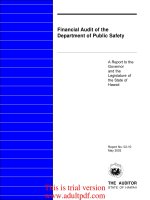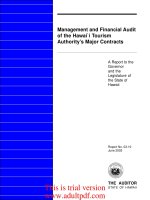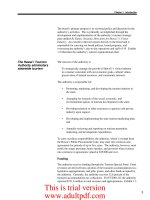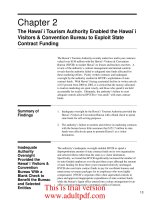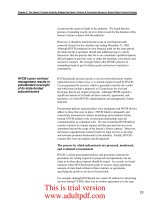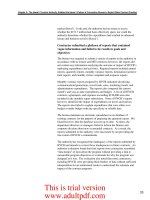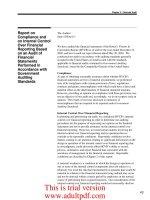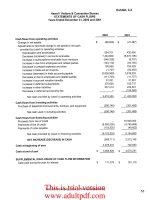Management and Financial Audit of Hawai‘i Tourism Authority’s Major Contracts A Report to the Governor and the Legislature of the State of Hawai‘i_part2 potx
Bạn đang xem bản rút gọn của tài liệu. Xem và tải ngay bản đầy đủ của tài liệu tại đây (368.4 KB, 10 trang )
3
Chapter 1: Introduction
At least six of the public members are required to have expertise in
visitor industry management, marketing, promotion, transportation,
retail, entertainment, or attractions. One member position is reserved for
a person with expertise in Hawaiian cultural practices. In addition, all
four Hawai‘i counties must be represented on the board. In developing
tourism policy recommendations, the HTA board is organized into
various standing committees as shown in Exhibit 1.1.
Exhibit 1.1
Hawai‘i Tourism Authority Board Committees
Administrative standing
committee
Makes policy recommendations related
to the evaluation of the executive director
and the administration of HTA.
Budget and audit standing
committee
Develops policies to ensure the nancial
integrity of the HTA through the proper
allocation and expenditure of funds in
a manner consistent with the board’s
policies and objectives, and ensures that
funds are properly expended under a
budget previously approved by the Board.
Marketing standing
committee
Makes policy recommendations on
initiatives that relate to promoting the
visitor industry.
Strategic planning
standing committee
Makes policy recommendations relating to
the research and planning areas.
Source: Hawai‘i Tourism Authority website
The authority, which has a staff of 23, is organized into four functional
divisions—administration, product development, marketing, and
communications—as shown in the organizational chart in Exhibit 1.2.
The chief administrative ofcer and director of marketing are responsible
for management of all the marketing contracts awarded by the authority.
The authority’s president/executive director reports to the board, oversees
the organization’s day-to-day operations, and represents the authority in
communications with the governor and the Legislature.
This is trial version
www.adultpdf.com
4
Chapter 1: Introduction
Exhibit 1.2
Organizational Chart of the Hawai‘i Tourism Authority
Executive
Director
Marketing
Director of
Marketing
Product
Development
Tourism Program
Officer
Communications
Communications
Officer
Administration
Chief Admin.
Officer
Sports
Events
Manager
Product
Development
Coordinator
Program
Specialist
Budget/
Fiscal Officer
Contract and
Program
Manager
Contracts
Specialist
Hawaiian
Cultural
Coordinator
Strategic
Planner
Tourism
Specialist
Source: Hawai‘i Tourism Authority
This is trial version
www.adultpdf.com
5
Chapter 1: Introduction
The mission of the authority is:
To strategically manage Hawai‘i tourism in a sustainable manner
consistent with our economic goals, cultural values, preservation of
natural resources, community desires and visitor industry needs.
The authority is responsible for:
Promoting, marketing, developing and conducting research for •
the tourism industry, and contracting for related research;
Creating a vision and developing a long-range, strategic plan for •
tourism;
Reviewing contractors’ expenditures of public funds by any •
visitor organization to perform tourism promotion, marketing,
and development of tourism; and
Submitting an annual report on its activities and expenditures, •
including descriptions and evaluations of programs funded, to
the Legislature and the governor.
To carry out these responsibilities, the authority, which is exempt from
the Hawai‘i Public Procurement Code, may enter into contracts and
agreements for periods of up to ve years, and ten years if relating to
contracts for the Hawai‘i Convention Center. The authority, however,
must notify the Senate President, House Speaker, and governor when it
enters into contracts or agreements valued at $25,000 and over.
The Legislature established three special funds administered by HTA to
support its mission. The Tourism Special Fund, the Convention Center
Enterprise Special Fund, and the Tourism Emergency Trust Fund receive
revenues collected from a portion of the transient accommodations tax
(TAT) as provided by Chapter 237D, HRS. The TAT is a 7.25 percent tax
levied on gross rental income from hotel rooms, suites, condominiums,
and vacation houses. Generally, the TAT applies to rentals by non-
residents for less than 180 consecutive days. It is collected in addition to
state general excise taxes.
Exhibit 1.3 summarizes HTA’s audited revenues and expenditures for all
funds for the past three scal years. The authority’s nancial statements
are comprised of the transactions contained in the Tourism Special Fund
and the Convention Center Enterprise Special Fund.
This is trial version
www.adultpdf.com
6
Chapter 1: Introduction
Exhibit 1.3
Hawai‘i Tourism Authority Revenues, Expenditures, and Fund Balances FY2004-05 Through
FY2006-07*
FY2004-05 FY2005-06 FY2006-07
Revenues
Transient Accommodations Tax** $96,334,000 $102,404,000 $106,087,000
Conference Center Operations 7,733,000 12,018,000 10,568,000
Interest 531,000 1,024,000 2,089,000
Other 2,000,000 185,000 981,000
Total Revenues $106,598,000 $115,631,000 $119,725,000
Expenditures
Contracts 68,746,000 74,451,000 76,819,000
Debt Service (Convention Center) 26,436,000 26,434,000 26,434,000
Personnel 1,570,000 1,950,000 2,093,000
Administrative 550,000 775,000 895,000
Transfer to DBEDT for Research 1,310,000 1,269,000 1,399,000
Convention Center Capital Fund Exp. 2,000,000 0 0
Total Expenditures $100,612,000 $104,879,000 $107,640,000
Excess of Revenues Over Expenditures
[Total Revenues – Total Expenditures]
$5,986,000 $10,752,000 $12,085,000
Fund Balances as of June 30 Year-end
Tourism Special Fund $17,926,000 $25,914,000 $31,973,000
Convention Center Enterprise Fund $1,126,000 $3,891,000 $9,917,000
*Rounded to the nearest thousand.
**Note that these totals comprise the amounts for both the Tourism Special Fund and the Convention Center
Enterprise Special Fund.
Source: Hawai‘i Tourism Authority audited nancial statements
This is trial version
www.adultpdf.com
7
Chapter 1: Introduction
The Tourism Special Fund
The Tourism Special Fund receives 34.2 percent of the TAT collected
annually, supplemented by income from investments, gifts, grants, or
other receipts the authority generates from its authorized activities. At
least $1 million of these funds must be made available to support and
protect Hawai‘i’s natural environment—the authority actually funded
nearly twice this amount in FY2006-07. Administrative expenditures
are limited to 5 percent by law. In addition, 0.5 percent must be held
in a sub-account to fund a safety and security budget provided for the
Hawai‘i Tourism Strategic Plan. For FY2006-07, the authority reports
that $71.5 million was available to pay for its operations and $2.9 million
for other purposes as shown in Exhibit 1.4.
Exhibit 1.4
Assignment of Tourism Special Fund Revenues FY2006-2007
for HTA Operations and Other Purposes
Total revenues, Tourism Special Fund $74,422,866
Expenditures for environmental purposes <$1,984,490>
Expenditures for security and safety budget <$963,645>
Revenues available for HTA operations $71,474,731
Source: Hawai‘i Tourism Authority
The Convention Center Enterprise Special Fund
The Convention Center Enterprise Special Fund receives 17.3 percent
from the TAT. Any amount of TAT revenues collected in a calendar
year that exceeds $33 million is deposited into the state’s general fund.
Additional revenues are derived from the operations of the Hawai‘i
Convention Center, any interest earned on unspent cash balances,
contributions, or appropriations. Expenditures for the Hawai‘i
Convention Center include the cost of operating, marketing, and
promoting, as well as debt service charges on the outstanding principal
balance of the general obligation bonds raised to nance the facility,
approximately $290 million. According to authority nancial reports,
revenues for the Convention Center Enterprise Special Fund were
$40.5 million, $45.2 million, and $45.2 million for scal years 2004-05,
2005-06, and 2006-07, respectively.
This is trial version
www.adultpdf.com
8
Chapter 1: Introduction
Tourism Emergency Trust Fund
The Tourism Emergency Trust Fund, which was established effective
July 1, 2007, provides for up to $5 million to the HTA board of directors
for use in the case of emergencies as determined by the governor, such
as conicts or disasters that disrupt commerce and affect tourism. The
emergency fund money comes from TAT revenues remaining after
deposits have been made to the Tourism Special Fund for tourism
promotion and visitor-industry research.
In 2003, the Hawai‘i Tourism Authority was in the process of revising
its tourism strategic plan, 2002 Ke Kumu, when it realized the need
for a more comprehensive and inclusive plan that addressed the
needs as well as identied the responsibilities of all Hawai‘i’s visitor
industry stakeholders. The authority contracted with a team of private
consultants, PBR Hawai‘i, to develop a ten year plan “intended to guide
all stakeholders in working together to attain the state’s vision for a
Hawai‘i that is the best place to live, work and visit.” Adopted in 2004,
the Hawai‘i Tourism Strategic Plan: 2005 – 2015 (TSP) is the State’s
tourism roadmap, providing an overall vision for Hawai‘i tourism in the
year 2015. The plan, which is organized into nine different initiatives,
provides strategic directions, specic goals, and responsible and
supporting partners for achieving that vision. The HTA is tasked with
the development and coordination of the Hawai‘i Tourism Strategic Plan,
but the primary responsibility of monitoring each initiative rests with the
lead partners identied in the plan. “In addition to this plan, the HTA,
as the State tourism agency, [would] update its own plan—Ke Kumu—to
identify specic action and implementation strategies consistent with the
framework of the TSP.”
The major contractors, the Hawai‘i Visitors and Convention Bureau
(HVCB), Hawai‘i Tourism Japan (HTJ), SMG for the marketing and
operations of the Hawai‘i Convention Center, and the National Football
League (NFL) were awarded $15 million or more over the life of their
multi-year contracts and fall under the authority’s marketing program.
Between July 2003 and June 2008, the Hawai‘i Tourism Authority has
spent nearly $270 million alone to attract leisure and business travelers
from North America and Japan through its major contracts with the
HVCB, HTJ, and SMG. Exhibit 1.5 shows the annual marketing funds
allocated to these three contractors for the period from the previous audit
to FY2007-2008.
Hawai‘i Tourism
Strategic Plan: 2005 –
2015
The Hawai‘i Tourism
Authority’s Major
Contractors include
HVCB, HTJ, SMG, and
the NFL
This is trial version
www.adultpdf.com
9
Chapter 1: Introduction
Hawai‘i Visitors and Convention Bureau
In 2007, the HVCB received a four-year contract extension for the
calendar years 2008 through 2011 to manage program planning and
marketing strategies for leisure tourism for the North American market
(United States and Canada) and corporate meetings and incentives
domestically and internationally. State funding to HVCB for the
calendar years 2006 and 2007 was $25.9 million and $27.2 million,
respectively, as shown in Exhibit 1.5. The marketing funds allocated
in 2007 to all the major market segments and SMG for marketing the
Hawai‘i Convention Center is shown in Exhibit 1.6.
Exhibit 1.5
Annual Marketing Funds Allocated to Major Contractors for July 2003 to June 2008
Calendar Year HVCB
Hawai‘i
Tourism
Japan
Fiscal Year
SMG, Hawai‘i Convention
Center
Total
Operating
Budget
Marketing
2003-04 $13,396,000 $5,800,000 $19,196,000
2004 $23,780,300 $7,796,000 $31,576,300
2004-05 $15,145,322 $6,500,000 $21,645,322
2005 $24,960,664 $8,085,912 $33,046,576
2005-06 $16,590,825 $6,500,000 $23,090,825
2006 $25,892,503 $8,838,342 $34,730,845
2006-07 $18,200,000 $6,500,000 $24,700,000
2007 $27,169,736 $8,903,996 $36,073,732
2007-08 $18,586,279 $6,500,000 $25,086,279
2008
(half year) $16,140,832 $4,136,615 $20,277,447
Total $117,944,035 $37,760,865 Total $81,918,426 $31,800,000 $269,423,326
Source: Ofce of the Auditor
This is trial version
www.adultpdf.com
10
Chapter 1: Introduction
Hawai‘i Tourism Japan
In July 2003, the HTA board of directors accepted a proposal from
Dentsu Inc., Japan’s largest comprehensive advertising agency, to
promote Hawai‘i in Japan. Dentsu established Hawai‘i Tourism Japan
(HTJ) to meet the needs of HTA—its sole client. On December 31,
2003, HTA and HTJ signed a four-year contract. The organization’s
Tokyo ofce began operations on January 5, 2004, with an executive
director and six staff members, all of whom were Dentsu employees.
The equipment was leased from Dentsu, which also charged a 10 percent
service fee. A liaison ofce in Honolulu was opened the same month as
the Tokyo ofce.
On March 1, 2007, the authority board of directors extended the term of
the marketing contract with HTJ for another four years (2008-2011). The
funding provided under HTA’s contract with HTJ for the calendar years
2004 through 2011 ranges from $7.8 million to $8.9 million per year,
a total of $66 million for the eight-year contract period. In addition, a
separate amount, approximately $390,000 per year, $3.1 million over
the life of the contract, is allocated for a consumption tax imposed on
business transactions in Japan. This tax is recoverable under Japanese
law and refunded each year to HTA after receipt.
Exhibit 1.6
2007 Major Market Segments Budget Allocations
2007 Major Market Segment Contractor Budget Allocation
North America (Leisure) HVCB $22,363,000
Corporate meetings and incentives HVCB $2,564,000
Hawai‘i Convention Center SMG $6,500,000
Sporting Events (e.g. PGA, Pro Bowl) $7,700,000
Japan HTJ $7,810,000
Asia Marketing Garden $1,070,000
Europe The Mangum Group $883,000
Oceania The Walshe Group $900,000
Source: Hawai‘i Tourism Authority
This is trial version
www.adultpdf.com
11
Chapter 1: Introduction
SMG (formerly known as Spectacor Management Group)
The authority contracts with the management, marketing and
development rm SMG to manage, operate, and market the Hawai‘i
Convention Center. A partnership headquartered in Philadelphia,
Pennsylvania, SMG is the nation’s largest provider of services in
management, marketing, and development of convention centers,
stadiums, arenas, and theaters. The company reports that it manages
more than 10 million square feet of exhibition and convention space
throughout the world, which were visited by more than 30 million
people.
Compensation to SMG is in the form of an annual management and
marketing fee, $397,023 and $412,904 for FY2005-06 and FY2006-07,
respectively. The contract provides for annual fee increases matching
the Honolulu Consumer Price Index up to 4 percent. In addition, SMG
is reimbursed for the actual costs of marketing, managing, and operating
the Hawai‘i Convention Center, subject to a budget approved by the
authority’s board of directors. The original 1996 contract, effective
through 2003, has been extended several times. The current contractual
term began in January 2003, with an extension option exercised in
September 2005, which runs through 2011. The funding approved by
the authority’s board of directors for operations and marketing under the
current term is shown in Exhibit 1.7.
Exhibit 1.7
State Funding for the Hawai‘i Convention Center, FY2003-04 Through FY2007-08
Fiscal Year Center Operations Sales and Marketing Total
2002-03 $13,737,658 $2,215,000* $15,952,658
2003-04 13,396,000 5,800,000 19,196,000
2004-05 15,145,322 6,500,000 21,645,322
2005-06 16,590,825 6,500,000 23,090,825
2006-07 18,200,000 6,500,000 24,700,000
2007-08 18,586,279 6,500,000 25,086,279
Total $95,656,084 $34,015,000 $129,671,084
*Half year 1/1/03 through 6/30/03
Source: HTA, SMG contract and supplemental agreement 1 through 28
This is trial version
www.adultpdf.com
12
Chapter 1: Introduction
National Football League—Pro Bowl
The authority’s contract with the National Football League (NFL)
provides for a fee paid to the NFL to hold its annual Pro Bowl game in
Hawai‘i, as well as for commitments to activities promoting community
involvement, the State of Hawai‘i, and the game itself. According to a
survey report commissioned by the HTA, the 2007 Pro Bowl attracted an
estimated 28,000 tourists to the game, most of whom were repeat visitors
to the state. In 2005, the NFL received $4.75 million for its services.
Thereafter, the contract provides $4 million per year until 2009 for a total
of $20.75 million.
We issued two reports on the Hawai‘i Tourism Authority. Our rst,
Management Audit of the Hawaii Tourism Authority, Report No. 02-04,
February 2002, was initiated because of legislative concerns about
inadequate explanations for the authority’s actions, especially the
spending of moneys seen as critical to the state’s economic well being.
The second, released in June 2003, Management and Financial Audit
of the Hawai‘i Tourism Authority’s Major Contracts, Report No. 03-10,
was the initial audit, and precursor of the current audit, required by
Section 23-13, HRS.
The rst audit report identied an array of deciencies stemming from a
lack of management and operational leadership and inadequate internal
controls to ensure that the authority account for its activities and those
of its contractors. Among our recommendations to the HTA board of
directors were:
To ensure that it achieves its mission by implementing a process •
to develop a comprehensive strategic plan; and
To ensure that future contracts are properly documented •
and supported, and clearly tie contractors’ remuneration to
measurable deliverables, and eliminate questionable contract
clauses.
Weaknesses identied in our rst audit were borne out in our 2003 audit
of the authority’s major contractors, which focused primarily on the
HVCB.
Our recommendations in the previous audit to the authority board of
directors and its executive director included:
Improve contractor accountability by:1.
Previous Audits’
Recommendations
This is trial version
www.adultpdf.com
